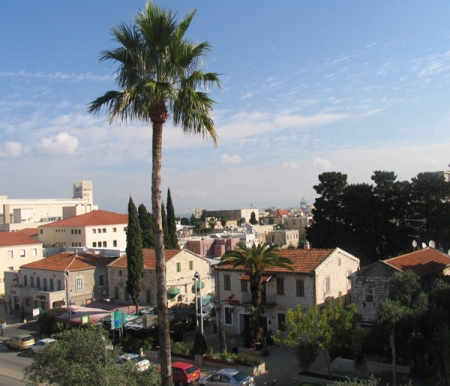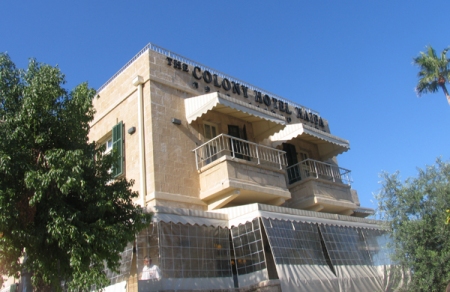
The Baha’i shrine and gardens are said to be the most-visited site in Israel.
Haifa is not just Israel’s prettiest city. It also has a major human asset: inhabitants of diverse faiths living side by side. The city’s month-long Holiday of Holidays in December celebrates this diversity through art, theater, dance, music, and food, in a grand mix of both high and low culture.
The festival began nineteen years ago, a year in which Christmas, Chanukah, and the Muslim holy month of Ramadan were said to have coincided. (In fact, if several on-line calendars are to be believed, Ramadan fell in March that year).It is a joint venture of the municipality and Beit Hagefen, the Arab Jewish Culture Center.

Beit Hagefen uses the arts to bridge the differences between the city’s diverse populations.
Concerts, art exhibitions, street theater, and an outdoor market with jewelry, crafts, and ethnic food take place mainly in two adjacent neighborhoods—Wadi Nisnas (Mongoose Gully) and the German Colony—where the population is mostly Arab (Christian and Muslim). An enormous plastic Christmas tree, flanked by large Chanukah menorahs, stands at the foot of Hacarmel Street, the broad main thoroughfare of the German Colony. Oddly missing are Muslim symbols; a lone representative—a crescent—can be found on the walls of Beit Hagefen, in a work of art representing the houses of worship of the three religions.
Each year, some artistic installations remain, so that visitors and residents can continue to enjoy them in subsequent years. Among the most striking works are those by Haya Touma, a Kishinev-born Jewish ceramicist whose art reflects the agony of the Palestinian-Israeli conflict. The artist was married to the historian Emil Touma, a Christian Arab who was among the proponents of coexistence between Arabs and Jews. One of her works, on an abandoned house, consists of a sculpted door topped by a photograph of a bride and groom, perhaps from the 1930s; to the side of the door is a plaque with the hand-written inscription: “Somebody lived here until 1948.” This is a reference to events in Israel’s War of Independence.

Haya Touma’s installation in Wadi Nisnas: “Somebody Lived Here until 1948”
On the eve of the war, the city had 130,000 residents, half of them Jews and half Arabs. When the British left suddenly, on the night of April 21-22, 1948, fierce fighting ensued. The Haganah captured the Arab quarters and took over the city; all but 3,000 of the terrified Arab residents fled. That summer, by order of the then prime minister David Ben-Gurion, Haifa’s Ottoman-era walled Old City, where many of the Arabs had lived, was razed. Today, 30,000 of Haifa’s 300,000 residents are Arabs.
Oddly, the city’s biggest attractions for tourists were built by neither Arabs nor Jews. The German Colony was a settlement of Templers, Christian visionaries who first came to Palestine in the 1860s and whose Haifa village was to be one of seven in the country.

The German Colony was built by Christian visionaries.
Throughout Palestine, the Templers (not to be confused with the Knights Templar) built roads, founded modern industries, and introduced new farming methods, which made them a welcome presence. Until World War II, that is, when some became Nazi sympathizers, giving the British an excuse to deport many of them; some were exchanged for Jews held in Nazi Germany.
The Templers built houses of smoothly finished stone, with thick walls to keep out the heat and humidity of this port city. Today their buildings house restaurants, cafes, boutiques, a museum, and the offices of Arab lawyers, accountants, and physiotherapists.
One building, originally the Templers’ Appinger Hotel, is today the 40-room boutique Colony Hotel, which has retained the colorfully patterned floor tiles and furnishings reminiscent of the period.

Just above the German Colony rise the magnificent Baha’i gardens and shrine, which city representatives say is the most-visited site in Israel. The golden-domed shrine is one of the two holiest sites for the five million members of the faith. It contains the remains of the Bab, the forerunner of the founder, Baha’ullah. It is this shrine, of a faith that preaches the unity of all humanity, that is a beacon to visitors approaching Haifa by sea.
And to add to the mix, Haifa has some 2,000 Ahmedis, members of an Islamic reformist movement that originated in India in 1889 and today has several million members in 200 countries. Ahmedis say they aim to purify the term jihad, claiming that in the Quran it never appears in a context suggesting war. They believe in disseminating their religion by peaceful means and have translated the Quran into 120 languages, including Yiddish. In Haifa they live in Kababir, a neighborhood that community head Muhammad Sharif says is “truly mixed.”
Of course, not all is idyllic in Haifa. It is still recovering from tensions and unrest that accompanied the second intifada, that began in September 2000. But it is a place where it seems that serious attempts are being made to heal the rift.
And Haifa is not just a place to experience multiculturalism. It is a gateway to the north of the country, where visitors can easily spend several nights and take day tours to Tiberias, Nazareth, Acco, Rosh Hanikra, and Caesarea. New hotels of all kinds are going up, and plans are afoot to move the port to the north, freeing the old port to be developed for tourism and entertainment, as something similar to the Tel Aviv and Jaffa port areas.
Text and photos copyright 2012 by Esther Hecht. No part of the text or photos may be used without written permission of the author.




